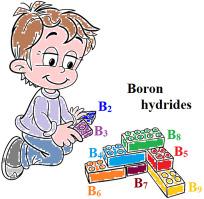低硼烷的化学性质:从合成和结构到反应性和应用
IF 23.5
1区 化学
Q1 CHEMISTRY, INORGANIC & NUCLEAR
引用次数: 0
摘要
这篇综述系统地概述了低硼烷的化学和性质(B₃到B₉范围内的氢化硼簇)。,重点介绍了它们的结构特征、合成方法、物理和光谱性质以及反应性。虽然单质硼不直接与氢反应,但由于硼的缺电子性质和多中心键的形成(例如,三中心双电子B-H-B和B-B-B键),大量的硼氢化合物表现出独特的结构和反应多样性。本文系统地介绍了该类主要代表化合物的合成方法,并详细介绍了它们的分子结构和光谱特征:二硼烷(B2H6)、四硼烷(B4H10)、五硼烷(B5H9、B5H11)、六硼烷(B6H10、B6H12)、八硼烷(B8H12、B8H14、B8H18)、非硼烷(B9H15)和八氢三硼酸盐阴离子[B3H8] -。讨论了每种化合物的制备方法、分子结构、光谱数据和关键的物理化学性质。强调阿尔弗雷德·斯托克和威廉·利普斯科姆在建立这一领域中的历史作用。一方面,这项工作旨在巩固广泛而分散的硼氢化物知识;另一方面,由于这一领域的浩瀚,有必要选择性地介绍最重要的数据。虽然硼氢化物已经被发现了几十年,但它们继续为研究提供丰富和动态的领域,在现代化学和材料科学中不断发现和应用。我们希望这篇综述能够为研究人员、学生和行业从业者提供宝贵的资源,促进这一前景广阔的领域的进一步探索和创新。本文章由计算机程序翻译,如有差异,请以英文原文为准。

The chemistry of lower boranes: from synthesis and structure to reactivity and applications
This review provides a systematic overview of the chemistry and properties of lower boranes (boron hydride clusters in the B₃ to B₉ range)., with emphasis on their structural features, synthesis methods, physical and spectroscopic properties, and reactivity. Although elemental boron does not react directly with hydrogen, the extensive class of boron-hydrogen compounds exhibits unique structural and reactive diversity, stemming from the electron-deficient nature of boron and the formation of multicenter bonds (e.g., three-center two-electron B–H–B and B–B–B bonds). The work systematizes synthesis methods and details the molecular structure and spectral characteristics of key representatives of this class: diborane (B2H6), tetraborane (B4H10), pentaboranes (B5H9, B5H11), hexaboranes (B6H10, B6H12), octaboranes (B8H12, B8H14, B8H18), nonaborane (B9H15), and the octahydrotriborate anion [B3H8]–. For each compound, methods of preparation, molecular structure, spectroscopic data, and key physicochemical properties are discussed. The historical role of Alfred Stock and William Lipscomb in establishing this field is emphasized. On one hand, this work aims to consolidate the extensive yet fragmented knowledge on boron hydrides; on the other hand, the vastness of the field has necessitated a selective presentation of the most essential data. Although borohydrides have been known for decades, they continue to offer a rich and dynamic domain for research, with ongoing discoveries and applications in modern chemistry and materials science. We hope this review will serve as a valuable resource for researchers, students, and industrial practitioners, facilitating further exploration and innovation in this promising area.
求助全文
通过发布文献求助,成功后即可免费获取论文全文。
去求助
来源期刊

Coordination Chemistry Reviews
化学-无机化学与核化学
CiteScore
34.30
自引率
5.30%
发文量
457
审稿时长
54 days
期刊介绍:
Coordination Chemistry Reviews offers rapid publication of review articles on current and significant topics in coordination chemistry, encompassing organometallic, supramolecular, theoretical, and bioinorganic chemistry. It also covers catalysis, materials chemistry, and metal-organic frameworks from a coordination chemistry perspective. Reviews summarize recent developments or discuss specific techniques, welcoming contributions from both established and emerging researchers.
The journal releases special issues on timely subjects, including those featuring contributions from specific regions or conferences. Occasional full-length book articles are also featured. Additionally, special volumes cover annual reviews of main group chemistry, transition metal group chemistry, and organometallic chemistry. These comprehensive reviews are vital resources for those engaged in coordination chemistry, further establishing Coordination Chemistry Reviews as a hub for insightful surveys in inorganic and physical inorganic chemistry.
 求助内容:
求助内容: 应助结果提醒方式:
应助结果提醒方式:


